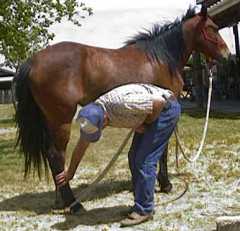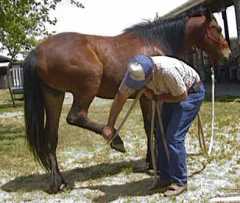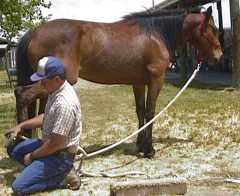Danny Love's Farrier's Corner
Teaching Your Horse to
Stand Quietly for the Farrier
Part Three
Using Ropes to Lift
By Willis Lamm
|
Occasionally we'll have a horse who either is overreactive
when we attempt to handle its feet (flips its feet up suddenly)
or tends to move off a little bit with each pick up. In either
event, it can be difficult to maintain hand contact on the
leg and get a solid lift.
In most cases we have found that additional desensitizing of the horse will resolve these issues. This work would include rubbing the horse all over with poles, brushes and hands and being able to come up to the horse from any direction and touch any accessible part without the horse flinching or moving away. But in spite of this preparation, a small number of horses will either still flip their feet or continue to move away when we attempt to pick up their feet. What we want to accomplish at this point is to make contact with the horse's legs and lift them into steady suspension. This is not really safe if the horse is whipping his leg around or is constantly adjusting his position. A rope can be used to desensitize the horse to being "held" from a much safer vantage point. For the rope, we will use a 12 - 15 ft. piece of 1 inch "Sampson line." This is a soft kernmantle maritime rope which provides great contact and won't burn the horse's skin. We'll start by flipping the rope around the horse's legs until he doesn't dance at its presence. Then we will bend a horseshoe around the long pastern and giving the lift cue, hold the horse's foot in suspension when he lifts. We're not going to fight with the horse, but rather provide some support so that the horse can balance on three legs and realize that it is OK to have one leg held up. Then we will position the leg at various heights, forward and aft, and let the horse get used to each. After a few lifts, we will reach down and make hand contact with the foot, releasing tension on the rope and maintaining the hoof's position with our hands. As the horse relaxes, the handler at the head provides positive reinforcement. When the horse stays steady, we'll get down to business and get those feet trimmed. Some horses may find balancing difficult when a hind leg is lifted, especially if they have unevenly overgrown hind feet or are tense in the hind end. For these horses, we actually place the hoof on an old saddle jack (a 4x4 piece of wood covered in carpet) with the dorsal wall of the hoof down on the jack and the bottom sticking out behind. This allows us to trim with less lift on the hind leg and the horse can maintain some balance pressure on his pastern (more for a sense of security than anything else.) By the time the nipping is done, the horse is usually relaxed enough to bring the hoof up across our knee in order to be dressed off with a rasp. The photo sequence on the right is of Sheba, a very guarded BLM wild mare who was very difficult to approach early on in her training. For the initial trim, Sharon stood at the head and kept the horse relaxed. The photos were taken a few minutes after and you can see that the mare learned, rather than was traumatized by the experience and stood quietly out in the middle of the stable lawn with the lead rope simply tucked into my belt. (I simply asked Sharon to get the camera and I just walked right up to her and "posed" her.) As with trailer loading, the act of trimming a green horse is in of itself a training process. You can either teach the horse to accept being trimmed or that the farrier is someone to be feared. A sensible training approach typically takes much less time than engaging in a fight and the future benefits are demonstrably much greater.
Return to:Clicker MethodPart 1Continue to:The Wild (Feral) Horse Hoof and its Natural BalanceTrimming Wild Horse Feet |
Note: The application of the rope is not intended to force
the horse to pick up her foot. It is used to safely maintain
contact and guide her foot once she's raised it until
she establishes balance and becomes used to having her foot raised.
Setting up the rope lift
|




